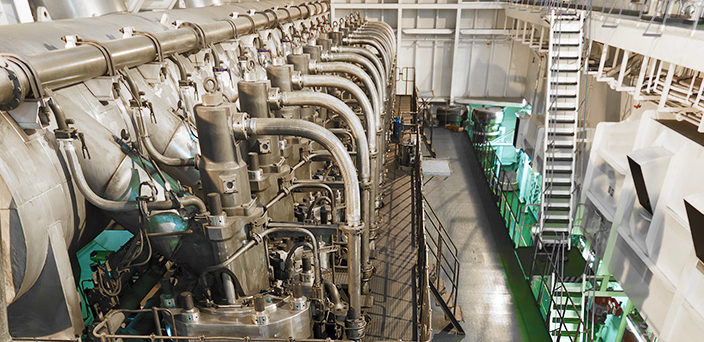The Gard P&I Club has issued a Case Study for the onboard safety meetings with focus on engine room fires. The case study consists of a short text describing a common task onboard most vessels, and a risk assessment form.
There are, in general, two types of engine room fires: oil or electric. Modern engine rooms have diesel fuel oil, lubricating oil, and hydraulic oil under pressure distributed throughout the engine room.
In a typical oil fire, the pipe or hose carrying the oil leaks. Since both hot areas and piping in the engine room are insulated, two faults need to be present for a fire to take hold. First, a break in the pipe and secondly a gap in the insulation. Below you will find a case study for onboard safety meetings. The title of this case is “Engine room fire”.
The incident
A laden bulk carrier was on passage between two ports in Europe. In anticipation of a larger electrical load due to cleaning of the cargo holds, auxiliary engines (A/E) Nos. 1 and 2 were on a parallel load-sharing configuration.
All the engine officers were present in the engine control room (ECR). A safety meeting was held to emphasise the importance of carrying out risk assessments, toolbox meetings and to discuss the lessons learnt from a recent incident onboard one of the sister vessels. During the safety meeting, the engine ratings were carrying out their assigned tasks. One of these tasks was the renewal and cleaning of lube and fuel oil filters. As the engineer officers were busy in their meeting, the ratings were not supervised in their work.
Suddenly, flames were seen between the two running generator engines. The fire alarm system sounded and the officers called the bridge in order to clarify if they could stop engines. Engineers then tripped the main supply breakers on the switchboard, stopped the auxiliary engines and all other running machinery whilst the emergency generator came on load.Now, thick black smoke reduced the visibility in the engine room, forcing all staff to evacuate the machinery space. While the crew mustered, the ventilation trips, flaps and quick closing valves were operated, to seal and isolate the engine room. The onboard fire team entered the space wearing heat protecting suits and Self-Contained Breathing Apparatus (SCBA) and extinguished the fire with portable and semi-portable extinguishers. The crew continued to monitor the space for any other outbreaks of fire.
A few hours later, they re-entered the machinery space to verify that the fire was completely extinguished. Subsequently, after carrying out all the appropriate operational safety checks, Aux. engine #3, (located on the lower platform), main engine and other machinery were restarted and the vessel resumed her passage.
Findings
In the evaluation and investigation after the incident, it was discovered that a sudden shearing of one of the three bolts that secures the lubricating oil filter of A/E #2 had displaced the cover. Lube oil under pressure splashed onto various hot components on both generators and ignited. It was also discovered that the lube oil primer pumps had continued to operate after shutdown of engines and generators, because of power being restored by emergency power source. This resulted in the spill of all the lube oil in the sump of the A/E #2 engine – which fed the fire.
It was also found out that the filter cover bolts were improperly tightened and there was a lack of proper inspection routines. Regular inspection is important as it is known that these fittings could be subject to excessive wear or loosen due to vibration / internal pressure. Spray shields and extra securing arrangements for cover bolts were not manufactured and fitted for lube oil pipes and filters for the auxiliary engines on board; and that had severe consequences for this vessel.
Further details may be found by reading the Case study below
Source: The Gard P& I Club





























































